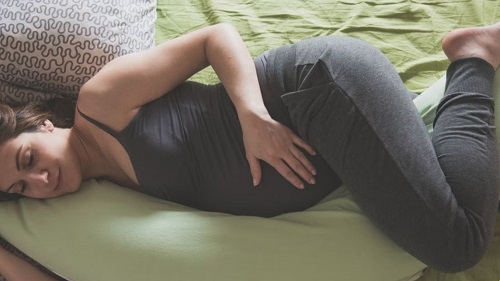Pregnancy brings many changes, and one of the biggest challenges for expectant mothers is getting a good night’s sleep. As the body adjusts to the growing baby, common issues like back pain, hip discomfort, and poor sleep posture arise. This can make restful sleep seem out of reach. However, learning how to sleep on a maternity pillow can make a significant difference. Maternity pillows are designed specifically for pregnant women, providing support to areas such as the belly, back, and legs. They help reduce pressure on sensitive points and improve overall sleep quality. Proper use of a maternity pillow can also promote better circulation, which is crucial for both the mother and the baby’s health. In this guide, we’ll explore why maternity pillows are essential, the different types available, and step-by-step instructions to ensure you get the most out of your pillow.

Why Is a Maternity Pillow Important for Pregnant Women?
Maternity pillows offer essential support during pregnancy by relieving pressure from critical areas of the body. As the baby grows, the increased weight can cause strain on the lower back, hips, and legs, making it difficult to find a comfortable sleeping position. Many women also struggle with maintaining proper posture during sleep, which can lead to long-term discomfort. A maternity pillow helps by promoting better alignment of the spine and providing cushioning to the belly and lower back. Additionally, the recommended sleeping position for pregnant women—on their side—can be difficult to maintain without the right support. Maternity pillows help keep the body in this position, ensuring optimal blood flow to the baby and reducing the risk of back pain and other aches. Ultimately, these pillows improve sleep quality, which is essential for energy and well-being during pregnancy.
Types of Maternity Pillows
Maternity pillows come in a variety of shapes and sizes, each designed to target different areas of discomfort. Understanding the different types can help you choose the best one for your needs.
U-shaped maternity pillows are the most popular option for full-body support. They wrap around the entire body, offering comfort for the head, neck, back, and legs. This type of pillow is perfect for those who shift positions frequently during the night.
C-shaped pillows are another great choice for pregnant women. They curve around the body, providing support to the belly and back while encouraging side sleeping, which is recommended for better circulation.
Wedge pillows are smaller, more compact options that target specific areas like the belly or lower back. They’re perfect for women who don’t want a full-body pillow but still need targeted relief.
Choosing the right pillow will depend on your comfort preferences and the areas you need to support the most.
Step-by-Step Guide: How to Sleep on a Maternity Pillow
Learning how to sleep on a maternity pillow properly is essential for reducing discomfort and getting quality rest. Follow these steps for maximum comfort and support.
Step 1: Position the Pillow Around Your Body
First, lay your maternity pillow on your bed and adjust it to suit your sleeping needs. If you’re using a U-shaped pillow, place it so that one arm supports your back and the other cradles your belly. The pillow should also be positioned under your head and neck for complete body alignment. For C-shaped pillows, tuck the bottom portion between your knees and let the top portion support your head while the middle curves around your back and belly. This helps relieve pressure on your hips, spine, and joints, making side sleeping more comfortable. Wedge pillows are smaller, so place them directly under the area that needs support, such as the belly or lower back. Adjust the height and position of the wedge to lift your belly or support your spine while lying on your side.

Step 2: Adjust Your Sleeping Position
After positioning the maternity pillow, lie down on your left side, which is the recommended sleeping position during pregnancy. This position enhances blood flow to the placenta and promotes better circulation for both you and your baby. If you’re using a full-body pillow, make sure that it’s supporting your head, neck, belly, and legs evenly. Ensure your spine stays aligned by keeping the pillow between your knees. This will reduce tension in your lower back and hips, helping prevent aches. If you’re using a wedge pillow, focus on ensuring that it keeps the belly supported without causing any strain. Proper positioning is essential for relieving discomfort, so take your time to adjust the pillow until you feel fully supported. You should feel immediate relief in areas like the back, hips, and legs once the pillow is correctly placed.
Step 3: Make Final Adjustments for Maximum Comfort
After you’ve adjusted the maternity pillow to your body, it’s essential to fine-tune the setup for maximum comfort. Start by gently repositioning the pillow around key areas like your belly, back, and legs, ensuring it feels natural and supportive. If you notice any discomfort or pressure in certain spots, make small adjustments to the pillow’s position until it provides the right amount of cushioning. For additional support, consider using smaller pillows under your head, neck, or lower back. This can help relieve pressure points that larger maternity pillows may not fully address. Ensure that your spine stays aligned, and that the pillow supports your hips to prevent any tension in the lower body. Take your time to experiment with different placements. Once everything is in the right place, you should feel a significant reduction in pregnancy-related discomfort. A well-positioned maternity pillow can make a noticeable difference in reducing common aches, helping you achieve restful sleep.
Common Issues and How to Overcome Them
While maternity pillows can be a game-changer for sleep, some women may experience difficulties when first using them. Common issues include the pillow feeling too bulky or shifting out of place during the night. For some, adjusting to the new shape and size of the pillow can be challenging. To overcome these problems, start by experimenting with different types of maternity pillows. If the full-body options feel too large, consider using a smaller wedge or C-shaped pillow that still offers ample support without taking up too much space in the bed. Additionally, try to adjust the pillow to fit your body as it changes throughout pregnancy. You may need more support in certain areas as your belly grows. Finally, don’t hesitate to add extra pillows for additional support if needed. Finding the perfect position might take some trial and error, but the comfort you’ll achieve will be worth the effort.
Conclusion
Knowing how to sleep on a maternity pillow can transform your pregnancy experience by reducing discomfort and helping you get the rest you need. These specially designed pillows provide much-needed support for the belly, back, and legs, allowing pregnant women to maintain proper posture and sleep more soundly. By choosing the right type of maternity pillow and learning how to position it correctly, you can relieve pressure on sensitive areas and sleep comfortably on your side, which is the recommended position for pregnant women. Proper use of a maternity pillow helps enhance circulation and alleviate common pregnancy-related aches, leading to better overall sleep quality. Although it may take time to find the perfect position, the benefits of sleeping on a maternity pillow are undeniable. With consistent use, you’ll wake up feeling more rested and ready to take on the challenges of each new day.
FAQ:
1.What is the best way to position a maternity pillow?
The best way to position a maternity pillow depends on its shape. For U-shaped pillows, wrap the pillow around your body so that one side supports your back and the other cradles your belly. If using a C-shaped pillow, place it between your knees and curve it around your back and belly for full support. Wedge pillows should be positioned directly under your belly or back for targeted relief.
2.Can I use a maternity pillow after pregnancy?
Yes, many women continue to use maternity pillows after pregnancy. These pillows can be helpful for postpartum recovery, particularly for supporting the body while nursing or sitting in bed. They can also provide comfort for general sleeping or relaxation, offering support to areas like the back and hips even after childbirth.
3.What type of maternity pillow is best for side sleepers?
For side sleepers, U-shaped and C-shaped pillows are ideal as they provide full-body support. These pillows help keep the spine aligned, reducing pressure on the hips and lower back, making side sleeping much more comfortable during pregnancy.
